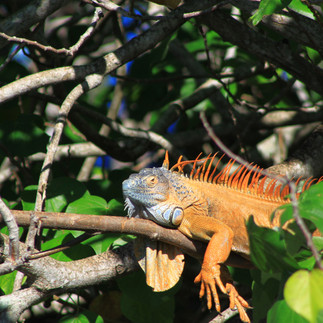FINALLY: The "Gross" Iguanas we Keep Posting About
- Kara Thornton
- Jan 19, 2022
- 3 min read
Okay hear me out... I'm usually so sweet to animals, never talking trash, but these scaley scoundrels are INVASIVE and super harmful to Florida's environment!!

Iguana iguana "Green Iguana" (mature male) Davie, FL 01/15/22
I know, I know, I'm a great photographer and make them look super cool and colorful... but don't be fooled! Like I said these are an invasive species to Florida and they're wreaking havoc... havoc I tell you!
you've already experienced the videos and chaos that are these animals. I highly recommend keeping up with what I've now started to call the "SPLAT CAM," where we watch from afar as these reptiles try to mate in high tree limbs and end up falling into the water. Later today we will be re-visiting the Iguana hot spot to try to catch some more action on video. Stay tuned!
So here's the skinny:
The Green Iguana is native to Central and South America. They were imported into Florida in the 1960s, most likely accidentally, as mindless moochers hitching a ride on cargo ships for cheap thrills. BUT, it has also been reported that in 1964 some money-hungry exotic pet dealer purposefully brought these beasts by the hundreds and released them into the wild. How that makes sense economically for their supply and demand is beyond me... but clearly this guy (I'm assuming guy) wasn't the brightest, nor did he take the time to consider any consequences to his actions.
As you'll see in some of our videos, these iguanas tend to bob their heads up and down when threatened. They're fast runners, using their tails to propel them forward, and they're even excellent swimmers, darting through the water to avoid predators or swim to the other side of a river to catch more sun. As cold-blooded reptiles they sun bathe to warm up and even climb into trees to perch on limbs for safety and full sun exposure.
Also, these animals are BOLD. Perhaps you've seen this viral video of two iguanas fighting at a resort then jumping into the pool to scare the poor visitors that are just trying to unwind for what I'm assuming is a well-deserved vacation. Just give it a rest!
The Consequences:
Green Iguanas thrive in urban areas and they bump uglies like no other. The populations have exploded and they're taking over! Between causing car crashes on roads, destroying seawalls and canal banks, and eating all the natural vegetation, these animals are causing serious damage at a rate we can't keep up with. They love to burrow underground and in doing so, cause sidewalks and foundations to collapse. In their native areas the Green Iguana is known to be a herbivore, but research shows they've started eating native tree snails in Florida, putting the snail populations in danger.
Y'all these things are EVOLVING and we've got to take action!
So what can we do now??:
Well... the solution is not pretty.
Basically don't be a dumbo -
Don't keep any as pets
Don't feed them
Don't even compliment their size or colors either!
(I'm convinced they've got an unhealthy ego)
But as far as real action goes, well its always beneficial to help native vegetation thrive to combat the damage these monsters are making. Plant native flora when landscaping, make sure to dispose of any non-native plants properly (don't just toss in the compost, thats how the Golden Pothos started to spread throughout FL!) Other than that, well... Florida has come to its wits end. That's right y'all, KILL THEM, humanely of course.
TLDR:
Green Iguanas in Florida are bad, bad!
Don't feed them for goodness sake.
Instead, make fun of them and even humanely **take care of them** if you have the means to do so.
If you're interested in how to *take care of them* Anne Geggis puts it pretty simply here.
Enjoy a gallery below of some of the Green Iguanas we've spotted here at CB Smith Park, in Broward County:
Sources:
.png)


















Comments